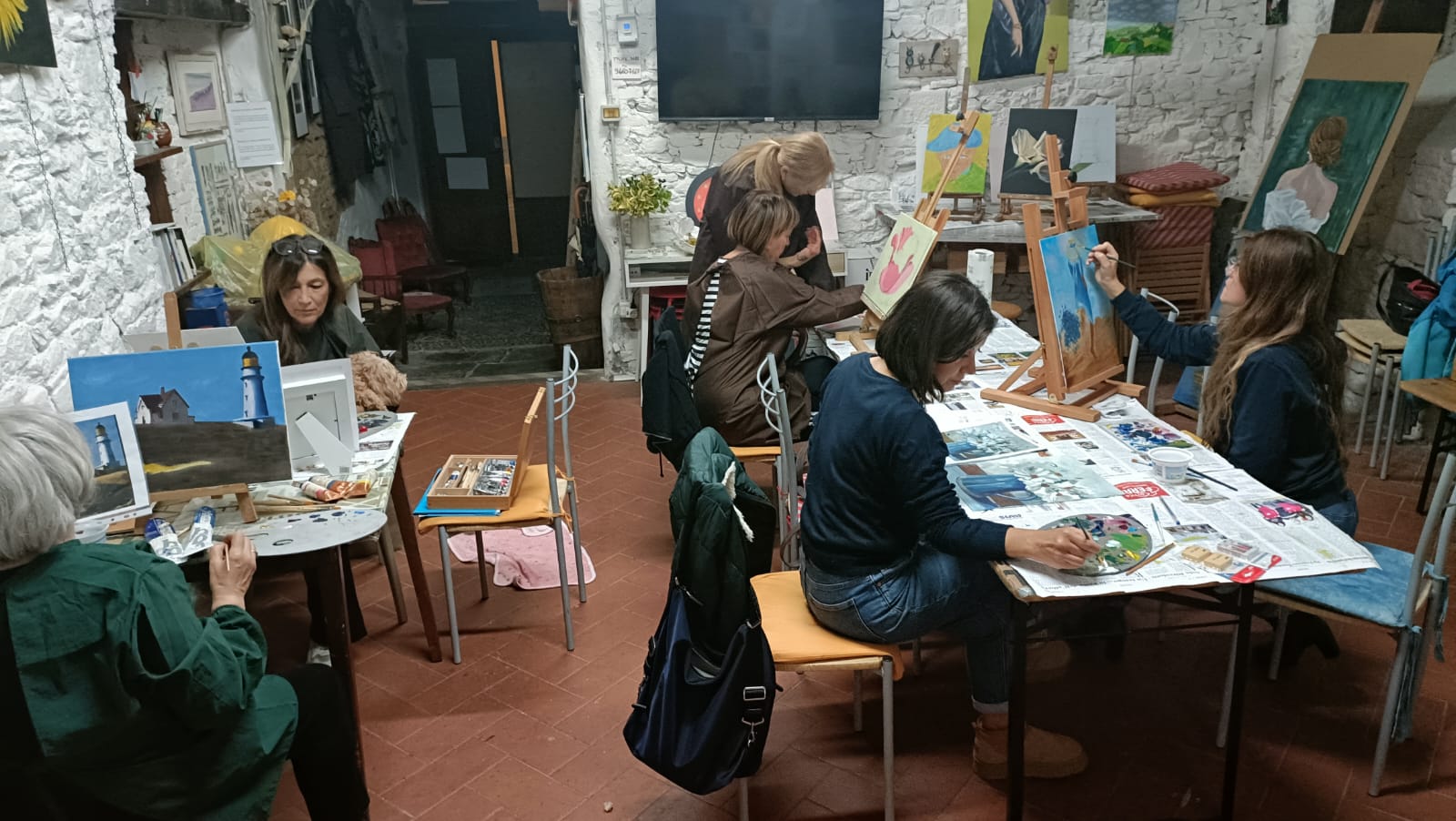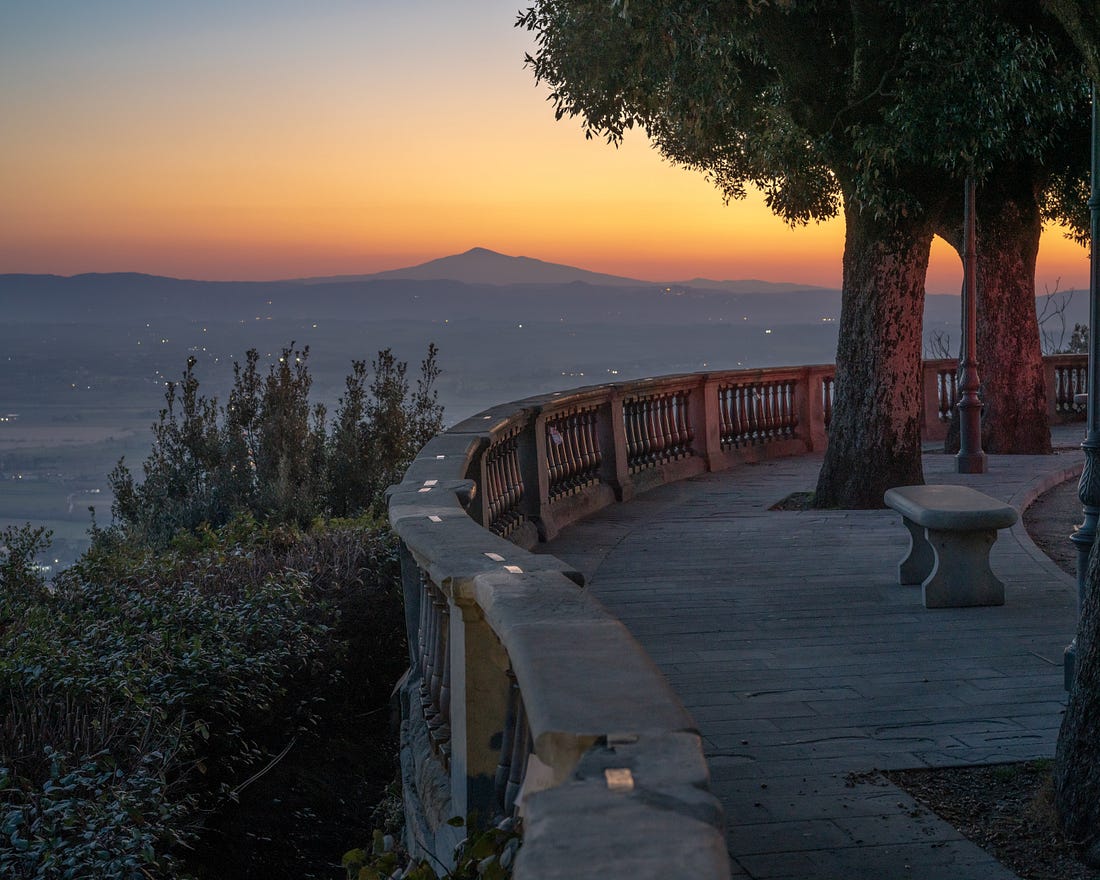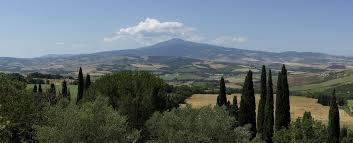Home from Home: a new series where we ask people with second homes in Cortona, to take a look at the home environments in which they live and explore the differences and/or similarities between the two. We kick off with writer Roger Jupe who shares his time between London and the mountains above Cortona with his wife, artist Val Archer.
VIVA LA DIFFERENZA: For the past 15 years my wife, the painter Val Archer, and I have split our time between London and our small casa and studio in the hills above Cortona. We feel privileged to live in two countries and regard both houses and the communities around them as home.
Most couples have common threads running through their lives. From the first time we met, ours was a love of painting. On our second date Val took me to see a Puccini opera at London’s Covent Garden. We married and started travelling, perhaps not surprisingly to Italy, to see the greatest art in the world, to explore the joys of Italian opera and the country’s food and wine, a thread that ran through my career in marketing and PR.
A cradle of Italian civilization and one of the greatest crucibles of modern European culture, Tuscany is a workshop of artistic experiences. Few places in the world can boast an artistic legacy so deeply rooted in the territory. At its centre, within easy reach of seven World Heritage Sites and where most of what we call Western civilization was either rediscovered or invented, is our local town, Cortona.
Of course, similar things could be said of London, a global cultural city of which there is no equal. But the differences are of course profound, often extreme. It is these differences that make our lives richer.
After 50 years living in London and visiting Italy for 25 of these before buying our Cortona house, we never tire of either place.
London existed for several centuries before anything approximating England had been thought of. Today it has a far stronger sense of itself and its identity than England, Scotland, Wales or Britain as a whole. It has grown, layer on layer, for two thousand years, sustaining generation after generation of newcomers.
We love London’s museums and galleries, its numerous music and opera venues, the proximity of these to our home, the extraordinary number of restaurants serving every type of cuisine from around the world. We delight in its melting pot of cultures, the city’s diverse and multi-ethnic society and their multitude of languages. London is a city in which you can never be bored.
One big drawback is that it is one of Europe’s most expensive cities, far more costly than any in Italy. Many people struggle to navigate its financial demands even though there are plenty of employment opportunities and average salaries are much higher than anywhere in Italy. Its population is huge and estimated to be nearly nine million, well over twice that of Rome.
Public transport is good while for those who prefer to drive, getting around by car and parking can be nightmare.
If you are lucky enough to own or rent a house that has a garden, this is likely to be very small. Everyone lives close together and while there are hundreds of parks, green spaces and waterways, the sheer number of people everywhere, most of the time, can wear you down.
Its size, combined with a dense road network and tall buildings, means central London is one of the most polluted places in the UK, although much is being done to reduce its contaminating impact. The plan is to make more than fifty per cent of the city green by 2050.
London has thirty-two boroughs and within each there are multiple different neighbourhoods, all with their own unique identity, atmosphere and attractions. We live in Wandsworth just south of the Thames, the river that runs through the city and flows into the North Sea. Our house is between two large green spaces, Wandsworth Common and Clapham Common. We are in walking distance of Battersea Park and fashionable Chelsea, Clapham Old Town and buzzy Brixton which has an energy like no other London neighbourhood.
Brixton village market
Clapham Common
Clapham Junction
We are blessed with shops and restaurants of every kind, pubs and cinemas, music venues and a thriving nightlife scene. Many young couples settle here and start a family. State and private schools are plentiful, most are good, and it’s a safe place to live.
Northcott Road
London has a lot to like. When we are here, the things we miss most about Cortona are our Italian friends and, on occasions, the peace and quiet of our part of the Tuscan countryside.
Yet, from the moment we cross the English Channel, we can’t wait to get to get through France and into Italy, head down the Mediterranean coast from Genoa, or the A1 autostrada, to arrive at our piccola casa and a enjoy a different, less hurried and, in many ways, simpler way of living.
We always drive because, unlike in London, a car is essential where we are.
We get up with the sun. We garden and grow own vegetables and fruit. I write and read, my wife paints and gardens and we eat at home most of the time. Walking in the local hills is one of our greatest pleasures.
Val at work
Our preferred living room is not in the house, but the terrace in front of it, from where gloriously green panoramic views meld into those of the Apennines on the horizon.
Evening meals are taken here under the stars beneath an endless sky devoid of light pollution and free from planes roaring as they descend over our London house towards the city’s Heathrow airport. Most of our waking hours are spent outdoors. If we need to go into Cortona, it’s always early or later in the day to coincide with la passeggiata. We don’t have a television preferring insteadRAI 3 radio and its excellent classical and jazz broadcasts.

Throughout our married life and well before we bought our Cortona house, we went on journeys of discovery all over Italy to see the work of its great painters. Their appeal was often enhanced by seeing their works in the ancient buildings for which they were created. This has remained one of our greatest pleasures to the present day. We still track down houses, chapels and palazzi, persuade custodians to open forgotten churches. Locally we never tire of seeing the paintings and frescoes of Piero della Francesca and his pupil from Cortona, Luca Signorelli; of Perugino, Pontormo, Giotto, Filippo Lippi, Cimabue, Ghirlandaio and Lorenzetti. Every time we discover something new. Here in Tuscany, unlike in many London galleries, we can get up close and imagine the artist at work. The more we look, the more we see.
For anyone who loves Italian opera and jazz, classical and popular music in all its forms, throughout central Italy and Tuscany, in most of its comuni including Cortona, world class music festivals and concert events are staged all the time. Many take place during the summer months.
The works of three of opera’s greatest composers, Puccini, Rossini and Verdi, are celebrated at annual festivals in the places where they lived: Giacomo Puccini at Torre del Lago near Lucca, Gioachino Rossini in the delightful Adriatic resort of Pesaro and Giuseppe Verdi in Parma. All are within easy reach of Cortona although we invariably spoil ourselves by staying locally at each and seeing two or three different operas on consecutive nights.
Nearer to home there is Perugia’s brilliant Jazz Festival plus the Trasimeno Festival at venues around Lago Trasimeno which this year hosts the famous pianist, Angela Hewitt. Cortona highlights include a celebration of sacred music and the town’s Kilowatt Festival showcases contemporary theatre, dance, circus, music and the visual arts. We especially like the intimate concerts that take place in the summer at La Foce and similar estates locally.
Italy takes festivity so seriously that every day, somewhere in the country, people are celebrating. While other things may have changed in the past, Tuscany especially remains constant in its devotion to celebration. Time stops, work stops, and its inhabitants dress up and indulge their profound talents in bringing the community together in events created with passion and vitality.
The occasions for such ceremony are both sacred and profane. The festivity may be the feast day of a saint or a recreation of a glorious event of the past. such as Arezzo’s spectacular Giostra del Saracino. joust. Our favourites are much more intimate, local sagre that honour the products of the land, from polenta to beef steaks, funghi to wild boar, and the ones in tiny hamlets, such as our local Teverina festa. Historically this is where dancing continues late into the night to the sound of an accordion band as I try, rather unsuccessfully, to perfect my Italian ballo liscio, ‘smooth dancing’, and not tread on anyone’s toes.
We have nothing like these in London. They are rituals that make life in Italy very special for someone not born in the country. So too getting into the habit of never, ever drinking a cappuccino after a meal, only before or during breakfast; accepting that the shops close for two or more hours for lunch; travelling miles to see a special fresco only to find that it’s
nel restauro and the building is
chiuso; getting into the passeggiata habit, that leisurely and socialising evening walk before or after dinner; ordering one of Italy’s many
digestive liqueursafter a big meal to supposedly aide digestion, something we never do in London.
Italians find it hard to believe that in Britain children are sent off to university in their late teens and asked to get a loan. They are amazed when we tell stories of sending elderly relatives to a home because they are deemed not useful to society any longer. In Italy we are constantly reminded that family is far and away the most important social, economic, organisational and, yes, political unit in the country.
In Cortona family values matter in a way that we never see in London. It’s impossible to overstate how important our neighbours are to us here, how they include us in family celebrations, are all always there for us, forever inviting us to eat with them. We love the way the old and very young, the teenagers and couples, the middle-aged and the over-nineties all sit together and relish each other’s company. Alcohol is not really an issue, which it can be in Britain when people get together. Sharing a meal is one of those rites that unites our Italian friends, and us with them. It seems good food, good wine, good company, family and friendship, generosity and laughter are essential to living like an Italian.
The moment we arrive in Cortona after our journey from London the conversation invariably turns to food. Our Cortonese neighbours have educated us about the importance of paying attention to the environment, to food provenance – knowing who, when, where and how things are farmed and made – along with eating what is in season. Living where we do in deep countryside, we relish the flavour of the things that grow wild, like blackberries and fragoline strawberries, and the vegetables we grow ourselves, especially the fennel in winter, peas in spring, salad leaves and tomatoes in summer, pumpkins in autumn.

Much of our life in Cortona revolves around growing, buying, preparing and the eating of food. Lunch and dinner choices are always part of our plans when we leave home to see art, to hear music or to discover another part of Italy. I have come to believe that Italians eat so well in comparison to the British, even us cosmopolitan Londoners, because eating enriches their sense of where they come from and who they are,
Italians are food centric people and we have found ourselves becoming like them.
We count ourselves lucky living between Cortona and London; to paraphrase Dante Alighieri “Noi non potremo avere perfetta vita senza amici italiani”.
Work in progress...view from Val's studio in Cortona
Roger Jupe, London, 07.03.2023
Viva la differenza = Long live the difference
Noi non potremo avere perfetta vita senza amici italiani = We cannot have a perfect life without Italian friends.















